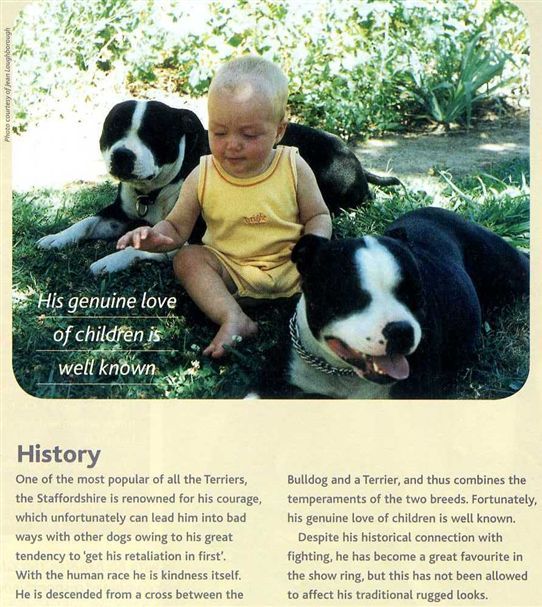
About The Stafford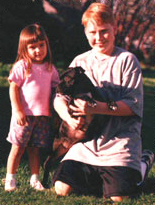
Is a Staffordshire Bull Terrier the right dog for you? Are you seeking a small to medium-sized dog with a short, sleek, easy-care coat? Looking for a companion par excellence whose greatest desire is to live life at your side? Perhaps you have read Jock of the Bushveldt, or have seen one of these canine dynamos performing in the agility ring at a local dog show. Maybe you’ve encountered a Stafford while out walking and wondered about how he could be playing so tirelessly with his owner and then stop and stand calmly, tail wagging, to accept the enthusiastic caresses of a toddler. The breed’s patience and gentle ways with children are legendary.
At first the Staffordshire Bull Terrier seems like a contradiction: he looks so tough, yet his approach to the human race is so loving and all-encompassing; “As early as three to four weeks of age,” says Stafford enthusiast and author Steve Eltinge, “a Stafford puppy will often prefer human companionship to that of his mother.”
The Staffordshire Bull Terrier standard speaks of the indomitable courage, high intelligence and tenacity that are the legacy of the breed’s history. These virtues, combined with a love of people and a reliable and stable nature, make the Stafford an extremely versatile companion. Author Dieter Fleig describes the breed as “a sort of everybody’s Man Friday.”

A good Stafford is never shy or reclusive and, conversely, should not be snarling and mouthy around people. The latter is not “game,” but unstable, and probably improperly socialized. Be aware, however, that the Stafford was originally bred to fight other dogs and that many still retain an antipathy toward strange dogs. Many Staffords also possess a strong “prey drive,” i.e., a desire to chase, catch and kill rodents and small mammals. That said, it must be added that a great many Staffords live in harmony with other household pets, having grown up with them in a properly supervised household.
Look for a friendly puppy or adult bursting with health and vitality. His keen, piercing and intelligent eyes should suggest complete awareness and even the possibility that he is reading your mind! In older dogs, the stance should be indicative of readiness: poised and up on the toes. Breed scribe John Gordon describes the aura of a temperamentally correct Stafford as, “vibratory in energetic outline.” Staffords of any age display a level of energy and a bounty of enthusiasm unequaled in the canine world.
The Stafford is often described as “a buff little dude” by admirers, but perhaps the words of an old cigarette advertising campaign best describe the appearance of the typical Stafford: “So round . . . so firm . . . so fully packed!”
Please check out our NATURE OF THE BEAST link to learn more about the mannerisms, abilities, and inclinations that make the Stafford unique in the world of dogs.
Nature Of The Beast
INTRODUCTION
The following is meant to introduce the uninitiated to the Staffordshire Bull Terrier. Because this link is more about the personality of the dog than it is an in-depth dissertation on breeding or training, anyone wishing to pursue either topic should refer to the books and magazines listed under the Club Bibliography Link In This Section (About The Stafford)
CHARACTERISTICS & TEMPERAMENT
Although individual differences in personality exist, there are some things that you can expect to find in the personality of every Stafford. They are tough, courageous, tenacious, stubborn, curious, people-loving and comfort-loving, protective, intelligent, active, quick and agile, and possess a strong “prey drive”. 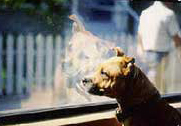 They are extremely “oral” youngsters and need a safe alternative to furniture, toys and clothing for their busy jaws. Staffords love to play tug-of-war and to roughhouse, but YOU must set the rules and YOU must be the boss. This is not a difficult task if you begin working with your Stafford when she is a puppy.
They are extremely “oral” youngsters and need a safe alternative to furniture, toys and clothing for their busy jaws. Staffords love to play tug-of-war and to roughhouse, but YOU must set the rules and YOU must be the boss. This is not a difficult task if you begin working with your Stafford when she is a puppy.
Most adult Staffords, particularly bitches, make excellent watchdogs; but in general they are inclined to protect people and not property. Their alert, muscle bound appearance is so striking that it’s easy to forget that they are smaller than most American Pit Bull Terriers. As Steve Eltinge in the book, The Staffordshire Bull Terrier in America says, “When a Stafford shows its teeth in a snarl, it can be frightening. They look tough and can be a positive deterrent to thieves, but because of their natural fondness for people, most Staffords are temperamentally ill-suited for guard or attack-dog training.” As with other members of the Bull and Terrier family, they can be the biggest people lovers in the world!
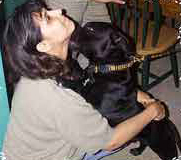 A Staffordshire Bull Terrier desires, more than anything else, to be with her people. Most adore a car ride, going on hikes and walks, enjoying a romp up the beach, and cozying up (or on) to you when you settle down for an evening of TV or reading.
A Staffordshire Bull Terrier desires, more than anything else, to be with her people. Most adore a car ride, going on hikes and walks, enjoying a romp up the beach, and cozying up (or on) to you when you settle down for an evening of TV or reading.
Whatever the activity, “From the time it awakens in the morning until the quiet of night, a Stafford lives life to the fullest.” (Linda Barker, writing in The Staffordshire Bull Terrier in America, by Steve Eltinge).
CARE AND TRAINING
Staffordshire Bull Terriers are a “natural” dog and generally robust. The short coat of this breed requires little grooming other than an occasional brushing and a bath. The downside of this drip dry coat is that Staffords are susceptible to fleas and ticks. The general remedies to discourage fleas and ticks are recommended, as well as a thorough going-over with a flea comb during the worse months of summer. Staffords covet human attention to the extent that I have seen several of them gather around their “person”, waiting to be combed from head to tail for fleas!
Care of nails, ears, teeth and anal glands are the same as they would be for any other breed (beginning when young and attention on a regular basis).
The Stafford is not a dog that tolerates weather extremes easily. Because of its short coat, i t prefers plenty of shade and water on sweltering summer days (a child’s wading pool has been a popular choice in the past; supervised of course). Its Bulldog ancestry and brachycephalic (short-headed or broad-headed) respiratory system can contribute to overheating. Watch carefully to be sure that your Stafford doesn’t become overheated during intense play in the summer; if she appears to be wheezing or gasping for air, find the nearest source of cool – not ice cold – water and soak her to lower her body temperature.
t prefers plenty of shade and water on sweltering summer days (a child’s wading pool has been a popular choice in the past; supervised of course). Its Bulldog ancestry and brachycephalic (short-headed or broad-headed) respiratory system can contribute to overheating. Watch carefully to be sure that your Stafford doesn’t become overheated during intense play in the summer; if she appears to be wheezing or gasping for air, find the nearest source of cool – not ice cold – water and soak her to lower her body temperature.
Staffordshire Bull Terriers can boast a number of obedience and dogsport degrees and are “quick studies,” provided the trainer utilizes a positive, creative approach. Staffords are smart with a capital S. Young puppies enrolled in Kindergarten Puppy Training classes can begin to learn good habits and mix with other puppies. In addition to AKC obedience competition, Staffords have been successful Therapy Dogs, Canine Good Citizens, participated in Agility and Flyball Competitions and even “gone to ground” with other terriers!
Staffords are exuberant, impulsive, sometimes bull-headed … and surprisingly sensitive. A trainer must learn to be persistent, patient, and firm. Rome wasn’t built in a day and a great deal of ground may be lost in trying to adhere to the sort of inflexible techniques and rigid time frame advocated by some training books. Basic obedience training (at the very least) is a must for any Bull and Terrier. It helps to maintain control in unexpected situations. Because of their impulsive natures, the other cardinal rule of Bull and Terrier ownership is “always think ahead.” An ounce of prevention is worth a pound of cure! When it comes to strange – and especially aggressive – dogs, few Staffords are complete pacifists. Most will not back down if they are attacked or menaced, and some just don’t get along with strange dogs, period. This is a physically and mentally tenacious breed; be prepared!
FREQUENTLY ASKED QUESTIONS
What are the differences between the American Staffordshire Terrier, a Staffordshire Bull Terrier, Bull Terrier, and an American Pit Bull Terrier?
Some eight or nine varieties of dogs come within the general classification of Bull Breeds. Although all lay claim to the Bulldog as a common ancestor, there are physical differences that make each distinct from the other:
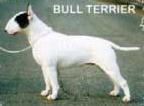 A) Size – The American Staffordshire Terrier (AmStaff) is a much larger, leggier dog – sometimes almost twice the size of a Staffordshire Bull Terrier! The Bull Terrier standard does not include size restrictions and dogs from 35 to 100 pounds have been seen. However, the breed generally weighs in between 40 and 55 pounds, making it larger then the Stafford. Pit Bull Terriers also range widely in size. Many of today’s UKC-registered APBTs are on the smaller side; others, dually registered as American Staffordshire Terriers with the AKC are larger and heavier.
A) Size – The American Staffordshire Terrier (AmStaff) is a much larger, leggier dog – sometimes almost twice the size of a Staffordshire Bull Terrier! The Bull Terrier standard does not include size restrictions and dogs from 35 to 100 pounds have been seen. However, the breed generally weighs in between 40 and 55 pounds, making it larger then the Stafford. Pit Bull Terriers also range widely in size. Many of today’s UKC-registered APBTs are on the smaller side; others, dually registered as American Staffordshire Terriers with the AKC are larger and heavier.
B) Ears – Although it may have natural or cropped ears,  the American Staffordshire Terrier is usually exhibited in the United States with cropped ears, as are some Pit Bull Terriers. The ears of the Bull Terrier are naturally erect. Erect (or prick) ears are a serious fault in Staffords, whose ears should be “rose” (like those of an English Bulldog) or half-pricked.
the American Staffordshire Terrier is usually exhibited in the United States with cropped ears, as are some Pit Bull Terriers. The ears of the Bull Terrier are naturally erect. Erect (or prick) ears are a serious fault in Staffords, whose ears should be “rose” (like those of an English Bulldog) or half-pricked.
C) Head – The heads of American Staffordshire Terriers, Pit Bulls and Staffordshire Bull Terriers are similar, although the cheek muscles on most Staffords seem to be more pronounced, and the head deeper through. The head of the Bull Terrier is entirely different. When viewed in profile, it resembles an egg turned on its side and is much longer than that of the Stafford. The cheeks of a Bull Terrier are not pronounced.
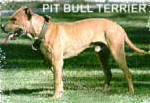 D) Temperament – All Bull and Terrier breeds have a natural love of people, although that love often does not extend to other members of the canine kingdom outside of the family circle. Many adult AmStaffs project a more serious demeanor; Bull Terriers have a unique and extremely well-developed sense of humor; Staffords may possess the strongest “prey drive” and the superior ability to focus; they are also an “emotional barometer” par excellence, very sensitive to psychic atmosphere in the home. But remember that every individual is different and each of these dogs shares a common ancestry.
D) Temperament – All Bull and Terrier breeds have a natural love of people, although that love often does not extend to other members of the canine kingdom outside of the family circle. Many adult AmStaffs project a more serious demeanor; Bull Terriers have a unique and extremely well-developed sense of humor; Staffords may possess the strongest “prey drive” and the superior ability to focus; they are also an “emotional barometer” par excellence, very sensitive to psychic atmosphere in the home. But remember that every individual is different and each of these dogs shares a common ancestry.
How are Staffordshire Bull Terriers with children?
The Stafford is known by the affectionate nickname, “The Children’s Nursemaid” or “The Nanny Dog.” Their tolerance of, and affection for, children is well known. That doesn’t mean, however, that it’s a wise idea of put the puppy and child together without supervision. Children should learn to respect the dog and neither should indulge in play that is too rough. Some Staffords – even the males – have a “mothering instinct” and will stick right by the little ones, whether they are puppies or kids. A Stafford, “tough” and not as quick to react to pain or discomfort, is likely to make allowance for the attentions of toddler, finding a refuge only when things become too overwhelming.
Can I keep a Staffordshire Bull Terrier in an Apartment? How much exercise will she require?
Staffords can make a home with you anywhere; they are happy as long as they are with you. They are an athletic dog, however, and need more exercise than most dogs. Bursting with energy, they need vigorous exercise every day! A long, brisk walk on leash (or harness – a useful alternative for some) will give you both a workout. Staffords love the heady freedom of being allowed off lead for a run, hike or romp and it’s delightful to watch them. Of course, it’s a good idea to make sure that they’ll come back when you call them, first.
Are Staffords a noisy breed?

Staffords, in general, are not mindless and persistent barkers. They may bark or “talk” while playing (you will be amazed by the range of arggling, yodeling, grunting, moaning and monkey noises, etc.!), or to alert you of a visitor. However, they are “quick studies” and if you have another dog in residence and THAT dog is a barker, your Stafford will probably pick it up.
They have such a nice, short coat. Do they shed?
In a word: “Yes!” . . . at least once a year. But because Staffords have a “hair” coat, rather than a multi-layer “fur” coat, they produce less dander and the shedding is minimal compared to what you may expect from a Golden Retriever or German Shepherd Dog. The close, short, glossy, “teflon” coat loses dirt easily, dries almost instantly, and does not absorb odor. Staffords are truly “wash and wear!”
What About Keeping a Stafford Outside?
Staffords are not temperamentally or physically suited to spending long periods of time out-of-doors. They need to be with their family and should be house dogs. Given the opportunity, they will convince you that they belong in the bed at night and will be most comfortable on the couch or in the car . . . wherever you may be. If you are not comfortable with this kind of intense camaraderie, do NOT buy a Stafford. Stafford-owners-to-be should have a fenced yard where their pet can play in safety. Remember that Staffords are terriers and can dig like the dickens. They can turn your garden or their yard into a minefield and have been known to go under or over a fence. Secure the bottom of the fence with an “L” of chicken wire. If your dog is the climbing type, a very tall fence or a “shelf” around the top will discourage him. To thwart thieves or those who might tease your Stafford, do not leave him out in the yard for long periods; supervise his outside time and take the opportunity to play with him. Remember that Staffords can overheat if they over-exert themselves on a hot day; conversely, their short coat offers little warmth in the winter months when they stop moving. IMPORTANT: Invisible fencing systems are not an appropriate alternative for Bull and Terrier breeds. The Stafford’s high pain threshold means that — if sufficiently provoked — he may cross the boundary with minimal discomfort. Once out, he must brave the boundary’s shock to re-enter the yard. Invisible fencing does not prevent strange dogs from invading his yard and harassing him . . . a potentially dangerous situation.
Do they like to swim?
Staffords can be divided into three categories when it comes to water — 1) They will do anything to avoid it, 2) They like to wade and wallow, 3) They enjoy full-body immersion and will swim, dive, and retrieve. BUT no matter which approach your Stafford may take to water, NO STAFFORD is really very seaworthy or buoyant. The percentage of body mass that is made up of muscle practically guarantees that they must work very hard to stay afloat. Therefore, a Stafford should NEVER be left alone near a filled swimming pool. More than one of these guys has paid with his life after falling in, struggling to remain afloat, and then tiring and sinking before anyone noticed.
Can I keep a Staffordshire Bull Terrier with another dog or with a cat?
Staffords, like members of any other breed, are individuals. While some may live peacefully with other animals, some will not. Puppies brought up with cats and other dogs generally do well. If bringing an older Staffordshire Bull Terrier into your home, first introduce the dogs away from the house in a neutral area. It should be easier to bring a Stafford into your home than bringing a strange dog into the home of a Stafford. Encounters should be supervised and the dogs observed to determine how a hierarchy develops.
with other animals, some will not. Puppies brought up with cats and other dogs generally do well. If bringing an older Staffordshire Bull Terrier into your home, first introduce the dogs away from the house in a neutral area. It should be easier to bring a Stafford into your home than bringing a strange dog into the home of a Stafford. Encounters should be supervised and the dogs observed to determine how a hierarchy develops.
Should I consider a male or a female?
Both will offer much love and affection. Females tend to be better watchdogs; males tend to be larger. If you already have a dog in your home, your choice is simpler: If you have a male, buy a Stafford female. If you have a female, buy a Stafford male.  This combination is the best, especially in a two-Stafford household. People sometimes ask about the wisdom of bringing two Stafford puppies home at the same time and most would advise against it. Each puppy deserves individual attention and is less likely to get it as a “twin.” Puppies are a lot of work! With two puppies to keep each other company, the temptation is often to let them amuse each other. Sometimes your pups will decide to bond with each other and place you second on the totem pole. You don’t want that! No matter which sex you select, spay or neuter if you have decided not to breed or exhibit your Stafford.
This combination is the best, especially in a two-Stafford household. People sometimes ask about the wisdom of bringing two Stafford puppies home at the same time and most would advise against it. Each puppy deserves individual attention and is less likely to get it as a “twin.” Puppies are a lot of work! With two puppies to keep each other company, the temptation is often to let them amuse each other. Sometimes your pups will decide to bond with each other and place you second on the totem pole. You don’t want that! No matter which sex you select, spay or neuter if you have decided not to breed or exhibit your Stafford.
I have a busy schedule and when I’m home I like to work undisturbed.
By all means, DO NOT BUY A STAFFORD! These dogs crave attention, companionship, and are tireless love sponges. This can annoy those who are used to a dog that amuses itself, is content to sit in its basket, prefers the companionship of another dog, or will settle for a quick occasional pat. Ignoring a Stafford or shutting it away from you will only make your pet an unhappy, frustrated nuisance.
I’m looking for a guard dog . . . will a Stafford fill the bill?
Staffords were not developed as watchdogs. Clare Lee, writing in The Pet Owner’s Guide to the Staffordshire Bull Terrier notes that, “he rarely barks, greets all your visitors and may well let them walk off with the family silver.” If you desire a dog that will be suspicious of all comers and actively repel them, then choose one of the working breeds designed for that purpose. Staffords may guard a car and will most definitely protect family members – especially the weaker members – but they rarely ‘guard’ the home.
What sorts of toys are safe to give my Stafford?
There are no such things as “indestructible dog toys” for Bull and Terrier  breeds. But some have tried these: Boomer Balls, Wolf-sized Nylabones, large-sized Kongs, or some of the Puzzle Cubes. Anything else might be chewed up, swallowed or destroyed in short order.
breeds. But some have tried these: Boomer Balls, Wolf-sized Nylabones, large-sized Kongs, or some of the Puzzle Cubes. Anything else might be chewed up, swallowed or destroyed in short order.
SO . . . DO YOU STILL THINK YOU’D LIKE A STAFFORDSHIRE BULL TERRIER?
It is recommended that you read as much as you can, go to local dog local shows in your area where you can see them, and contact one of the breeders listed in the SBTCA Breeders Directory to ask questions and arrange to see dogs. And above all, be sure that everyone in your household wants this energetic and loving addition. A Stafford could easily be dependent upon you for the next 16 years!
Origins

Although there has been some discussion through the years about the origin of the Staffordshire Bull Terrier, authorities generally agree that the breed can be traced back to the Mastiff-like dogs through the old Bulldog which, when crossed with British terriers, produced the first “Bull and Terriers.” Books published in the early 1800s which refer to “Bull and Terriers,” “Pit Dogs”, and “Fighting Dogs” confirm that the cross existed at that time.
The old-fashioned Bulldog was a fierce, courageous animal used in the sports of bear- and bull-baiting as early as the mid-sixteenth century. When these sports fell from public favor and were outlawed, their supporters turned to dog fighting and sought to create a sporting dog that, while retaining the legendary courage and ferocity of the Bulldog, would incorporate the greater agility of the terrier.
Refinement
Terriers thought to have been used in the cross are the Manchester Terrier and the now-extinct English White Terrier. In addition, crosses with various of the old working terriers were made.
 Because of the attentions of different groups of English fanciers, two distinct types of Bull and Terrier arose and, by 1900, they were easily distinguished. James Hinks’s elegant white dogs, produced by crossing the predecessor of the modern Bulldog with the English White Terrier (and some say Pointer and Dalmatian) were recognized by the Kennel Club (UK) and the American Kennel Club at the turn of the century. This “White Cavalier” is known today as the Bull Terrier.
Because of the attentions of different groups of English fanciers, two distinct types of Bull and Terrier arose and, by 1900, they were easily distinguished. James Hinks’s elegant white dogs, produced by crossing the predecessor of the modern Bulldog with the English White Terrier (and some say Pointer and Dalmatian) were recognized by the Kennel Club (UK) and the American Kennel Club at the turn of the century. This “White Cavalier” is known today as the Bull Terrier.
The other Bull and Terrier — the Stafford, which was owned by the common man — was not as easily “legitimized.” Fanciers of the “working class dog” met in England in 1935 to form a club for the Staffordshire Bull Terrier fanciers and draw up a Breed Standard.
Recognition
In 1938, the first Championship points were awarded in Birmingham. The first two members of their sex to claim championships in England were the bitch, Lady Eve (far left) and the dog, Gentleman Jim (near left) in 1939.
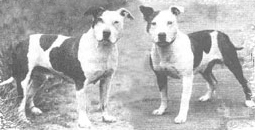 The first Staffordshire Bull Terriers brought to the United States lived their lives out simply as companions; it was not until 1975 that The American Kennel Club recognized the Staffordshire Bull Terrier as a registerable breed that could be shown outside of the Miscellaneous Classes. The first Stafford to be registered in the American Kennel Club Stud Book was the English import, Ch. Tinkinswood Imperial. The first U.S. champion was a bitch, the Australian import, Northwark Becky Sharpe.
The first Staffordshire Bull Terriers brought to the United States lived their lives out simply as companions; it was not until 1975 that The American Kennel Club recognized the Staffordshire Bull Terrier as a registerable breed that could be shown outside of the Miscellaneous Classes. The first Stafford to be registered in the American Kennel Club Stud Book was the English import, Ch. Tinkinswood Imperial. The first U.S. champion was a bitch, the Australian import, Northwark Becky Sharpe.
The Stafford is a well-kept secret: smart, healthy, rough and tumble, comfort-loving, and a family pet and chum without equal when properly trained and socialized. One of the best known terriers in The British Isles (where at least 15 Stafford clubs exist), it is also one of the ten most popular dogs in Australia and the most popular terrier in South Africa. In the U.S., it is often mistaken for its cousin, the American Pit Bull Terrier, which has established a greater foothold there.

The Staffordshire Bull Terrier Standard At A Glance………..
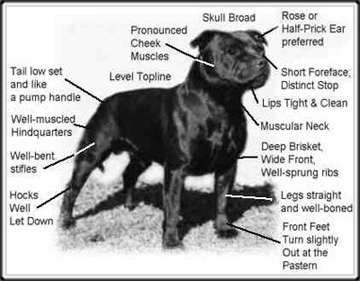
The drawing, above, gives a basic overview of the Staffordshire Bull Terrier Standard. View the complete AKC standard by clicking here. Return to this page by using your “BACK” arrow.
Acceptable Stafford Colors
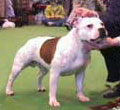 |
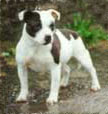 |
 |
|
 |
 |
 |
|
 |
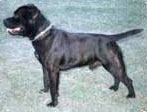 |
||
(L-R) Top Row: Skewbald (white with red spots), Piebald (white with black or brindle spots), White. Middle Row: Blue, Fawn, Red. Bottom Row: Brindle, Black Brindle.
Black and tan or liver colors are undesirable; dogs of these two colors will be disqualified in the AKC show ring.
What is BSL?
Imagine the following scenario about you and your dog. You own a dog that you love. You’ve spent time and money on food, vet care, toys, training, and other expenses. You are a law-abiding owner. You keep your dog on a leash & pick up after her when you walk her. Your dog is registered with the county, has all the required vaccinations, & is well behaved. Perhaps she is a certified therapy dog, has passed the AKC Canine Good Citizen test & the American Temperament Test. She’s part of your life & your family. Then, months, possibly years, after you have lived with her, the police show up at your door. They tell you that the local government gives you two options: move your dog to a place where “her kind” is allowed, or turn her in to animal control, where she will be destroyed. HUH? WHY? She has never attacked anyone. She’s never bitten anyone or anyone else’s dog. She doesn’t bark all day long. She doesn’t dig or chase the neighbor’s dogs or cats. You don’t allow her to roam loose, unattended in your neighborhood. So why is the government after your dog? Because her type has been placed on a list of “dangerous” dogs: dogs that are, because of their physical features, condemned as being “vicious”. This is the unfair reality that hits owners in cities, states, or countries where Breed Specific Legislation (BSL) is enacted. Breed Specific Legislation, or BSL, is any law (generally a city, county, or state law) that attempts to force a dog owner to do any of the following for owning a certain type of dog:
• Have extra liability insurance, generally totaling over $100,000 to cover the dog
• Muzzling whenever the dog is on public property, or not allowing it to leave the
owner’s property at all
• The complete removal of that type of dog from an area, whether by forcing
owners to give up their dogs for euthanasia or requiring them to move their
families or their dog somewhere else.
BSL is an attempt at quelling a problem that is not rooted in one specific type of dog,
which is where the laws immediately fail. The problem lies in many things, such as
irresponsible breeding, neglect, or incorrect, dangerous training; however, breed alone is
not the issue. Not only does it fail to address the real problems behind the dangerous
dogs, but also it is extremely difficult, if not impossible, to enforce.
And just who is fueling the fire, whipping up the flames of this hysteria? Who is driving
the onslaught of anti-dog legislation? Your local paper, TV or radio station – with
inaccurate reports which use inflammatory language & show unrelated footage of
dogfights. Every time a dog attacks it is suddenly reported as being a ‘pit bull’ no matter
what the breed or mix is. Why isn’t the finger pointed to the owner? Across the country –
and around the world – cities, counties and local town councils are busy banning or
restricting breeds instead of punishing irresponsible substandard behavior.
• Breed bans – an outright ban on owning a specific breed of dog
• Breed-specific sterilization – owners are forced to spay or neuter animal
• Breed-specific insurance requirements – forces owners to obtain the unobtainable “vicious” breed insurance – in reality this forces owners to surrender dogs or move
• Weight or size restrictions – banning dogs over an arbitrarily determined weight or size – as in Fairfield, Iowa where all dogs over 100 lbs are banned (St. Bernard, Newfoundland, Irish Wolfhound, Great Dane, etc.)
“The formula for creating a dangerous dog has been demonstrated (use in negative functions, abuse, poor socialization, chaining, dogs maintained as a pack, etc.). The formula for creating a dangerous breed is something entirely different. Since no breed of dog is inherently vicious, the creation of a ‘viciousbreed’ is in reality the creation of an image.”
– Karen Delise
